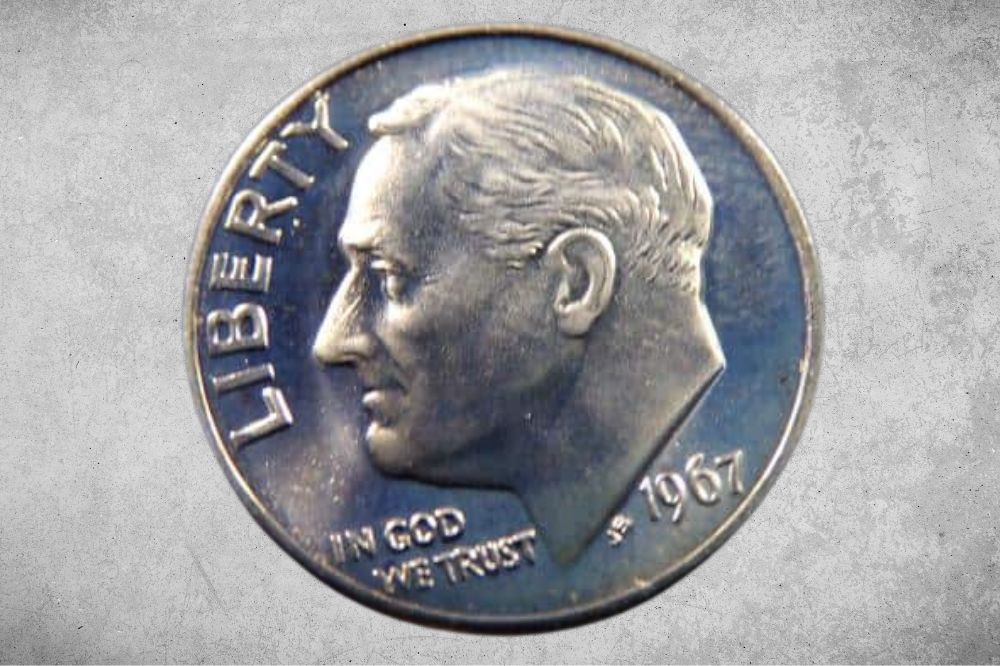Not every coin needs to have a high face value to be expensive after a while. Furthermore, not every coin needs to be all that valuable monetarily to be fascinating and valuable to collectors.
A fine case in point of that is the 1967 dime, also known as the 1967 Roosevelt dime as it bears the portrait of American President Franklin D. Roosevelt. Let’s examine this interesting coin together below.
1967 Dime Details
- Category: Roosevelt Dimes (1946-Date)
- Mint: Philadelphia
- Mintage: 2,244,007,320
- Obverse Designer: John R. Sinnock
- Reverse Designer: John R. Sinnock
- Composition: 91.67% copper / 8.33% nickel
- Diameter: 17.9 mm
- Edge: Reeded
- Weight: 2.27 g
The famous Roosevelt Dimes were first minted in 1946, a year after the death of the beloved US president. Their mintage continued for decades and still takes place today, at the time of writing this article. The 1967 Roosevelt dime is a bit special, however, and for more than one reason too. But, before we go into the 1967 dime’s history, let’s take a look at its value.
1967 Dime Value and Grading
1967 Dime Value Chart |
||||
| Mint mark | Good | Fine | Extremely Fine | Uncirculated (~MS 68) |
| No Mint Mark | $0.10 | $0.15 | $0.15 | $65+ |
| Special Mint Set | n/a | n/a | n/a | $350+ |
1967 dimes are graded like any other coin, using grading systems such as the Sheldon grading scale or other similar ones. The reason we used simpler terms such as “good” and “fine” above instead of actual grades such as AU 53 or VF 25 is that 1967 dimes that aren’t uncirculated (haven’t been in circulation) and aren’t of ultra-high quality (i.e. have no wear and tear defects) just won’t sell past their face value anyway.
At best, an “extremely fine” dime of, say, an MS/PF 60 grade, will be worth a few times its face value or a few dollars at most – hardly anything that’d make you rich. The only 1967 dimes that sell in the hundreds of dollars are either those from the Special Mint Set which we’ll talk about below or no-mint dimes that are just as well preserved as physically possible.
For a few video tips in 1967 dime grading for the visual learners among you, here is a neat video to check out.
1967 Dime Value and Varieties Guides
1967 Dime With No Mint Mark
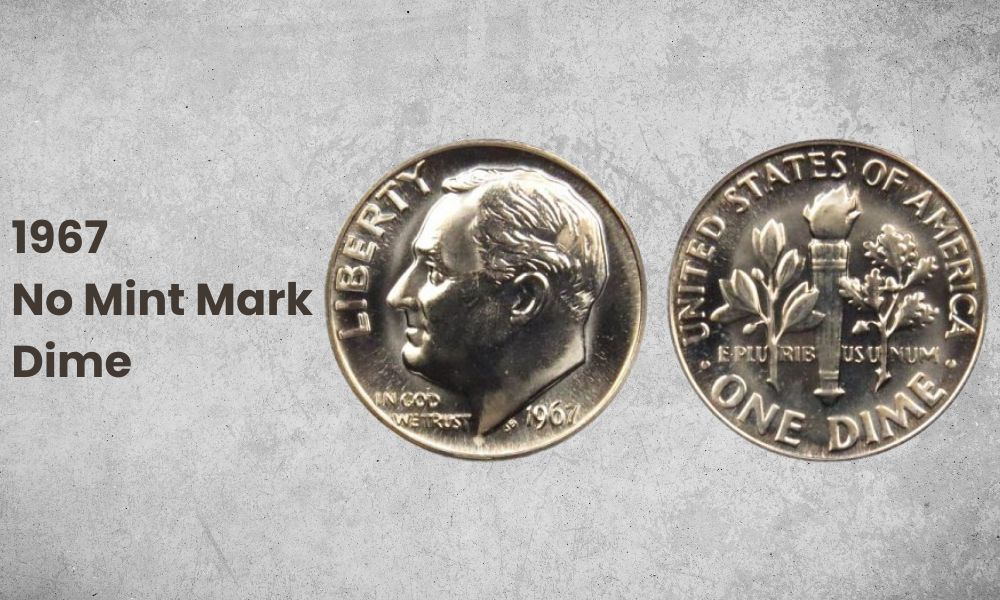
- Place of minting: Philadelphia
- Mint mark: John R. Sinnock’s initials
- Year of minting: 1967
- Face value: $0.10
- Current $ price: $0.15 unless the coin’s quality is truly outstanding
- Quantity produced: 2,244,007,320
- Designer: John R. Sinnock
- Edge: Reeded
Printed in the millions, 1967 no-mint dimes are still in circulation today and more of them are still produced, just of later variations with different mint marks. This commonness of the 1967 Roosevelt dime together with its low face value means that there is no way for such a coin to ever be overly valuable for collectors unless there is something extraordinary about its quality and/or there are some unique errors in its production.
1967 Special Mint Set Dime
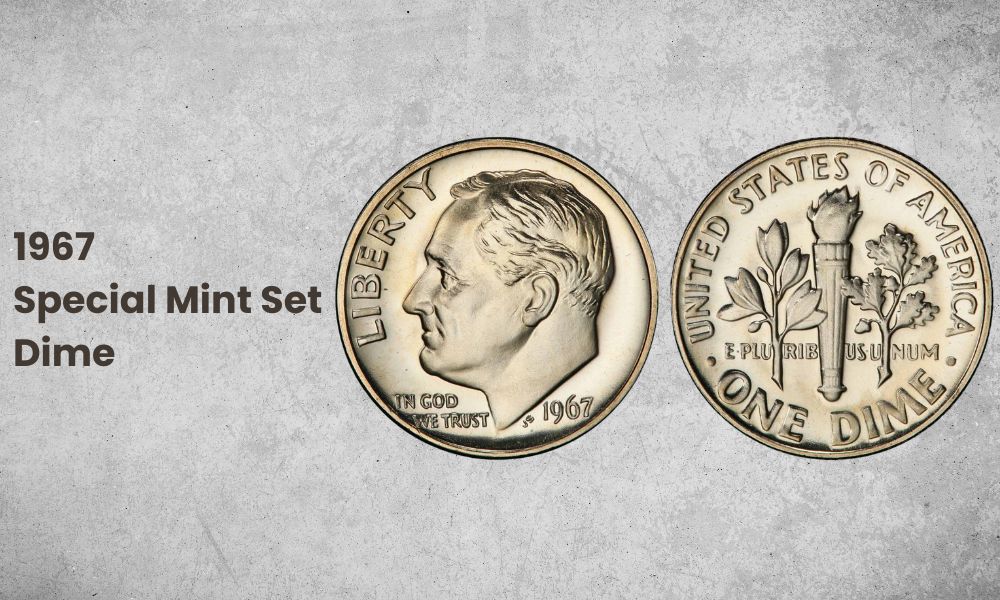
- Place of minting: San Francisco
- Mint mark: John R. Sinnock’s initials
- Year of minting: 1967
- Current $ price: Up to several hundred dollars, depending on the coin’s quality
- Quantity produced: 1,863,344
- Designer: John R. Sinnock
- Edge: Reeded
Special Mint Set dimes are indeed more valuable that the commonly circulated no-mint 1967 Roosevelt dimes. Yet, it is interesting that the higher end of both variants is the same – in the $300-$400 range when the quality of the coins is good enough. So, even though SMS 1967 dimes are more valuable overall, you can get the same top price with a no-mint dime too if you’re lucky.
The other key differences between the two are that the SMS was stricken by the San Francisco mint rather than the Philadelphia mint. Yet, even the SMS dimes don’t have an “S” mint mark but have the “JS” initials of John R. Sinnock.
Also Read: Top 15 Most Valuable Roosevelt Dimes Worth Money
1967 Dime History
The relatively low value of the 1967 dime doesn’t mean that this coin isn’t remarkable – it’s just that it’s a dime and Roosevelt dimes are incredibly common and even 1967 dimes are still in circulation. Nevertheless, what makes these coins interesting, especially if they are well-preserved and uncirculated, are a couple of peculiarities.
First, the 1967 Roosevelt dime is different from other Roosevelt dimes because it doesn’t have a mint mark. That’s because, unlike most others, it was only produced by the Philadelphia mint and not by the Denver and San Francisco mints too. Since the mint mark is there to identify which mint the coin has come from, there was no need to put a mint mark on the 1967 dime – the year was enough to signify its point of origin.
So, instead of putting the letter “P” on the coin, it was decided to put the initials of John R. Sinnock – “JS” – on the mint mark’s place, to commemorate the engraver’s contribution. This can be confusing at first if you’re not aware of this rare practice as most people just expect to see the letters “P”, “D”, or “S” on their coins.
Another interesting historical tidbit about the 1967 dime that has to do with its Philadelphia mintage is that this was the first Roosevelt coin to ever be produced in such huge quantities from a single mint rather than from all three. With 2,244,007,000 Roosevelt dimes pumped up by the Philly mint in 1967, this was the first time these coins went over 2 million from a single facility.
All this was happening soon after the switch from silver coins to nickel and copper coins which happened in the early 1960s. So, while the 1967 isn’t the first Roosevelt dime that isn’t made with silver, it is one of the first – this doesn’t make it more monetarily valuable, of course, but it does make it more historically valuable.
As a last point of interest, the 1967 Roosevelt dime is the first Roosevelt dime to not have any proof sets as those were temporarily halted in 1967. For those wondering, “proof sets” are typically a limited edition set of coins minted alongside the “regular” coins that are meant for wide circulation. Proof coins are also of a higher quality as they are stricken with more precise equipment.
Proof coins were first meant to “prove” the validity of other coins by providing a standard for comparison. As with all other rare things, however, they quickly became collectors’ items that the Mint was selling to numismatists for profit.
This wasn’t the case in 1967, however, as there was a coin shortage at the time and the mint didn’t want to waste any resources with proof sets. While those did sell very well, they were also expensive to strike as they required entire separate sets of hardware to produce.
So, instead of a proof set of 1967 dimes, the Mint made Special Mint Sets (SMS). These weren’t of as high of a quality as proof sets but they were still substantially better than the regular coins while still cheaper to strike than proof coins.
Another difference is that, while the widely circulated dimes were of a 91.67% copper / 8.33% nickel composition, the SMS dimes were made with a ratio of 98.67% copper and 2.33% nickel. There were quite a lot of them too – 1,863,344 SMS 1967 dimes were printed in total by the San Francisco mint (not by the Philadelphia mint).
This practice of focusing on Special Mint Sets rather than on proof coin sets continued for two more years until proof sets started getting made again in 1970. All this means that, while the 1967 SMS dimes aren’t as expensive as they would have been if they were proof dimes, they are also quite unique from a historical standpoint.
All in all, as you can see, while 1967 dimes aren’t all that monetarily valuable and are just another year of printing Roosevelt dimes, there are actually quite a lot of unique things about them.
Lists of 1967 Dime Errors
Given how common these coins are, the only thing that can inflate their value by at least a little bit – in addition to good preservation quality – are some rare and interesting errors. In the case of the 1967 Roosevelt dime, there are a few to watch out for. And, if you prefer more visual examples, watch the video above to check out.
1967 Dime Blank Planchet
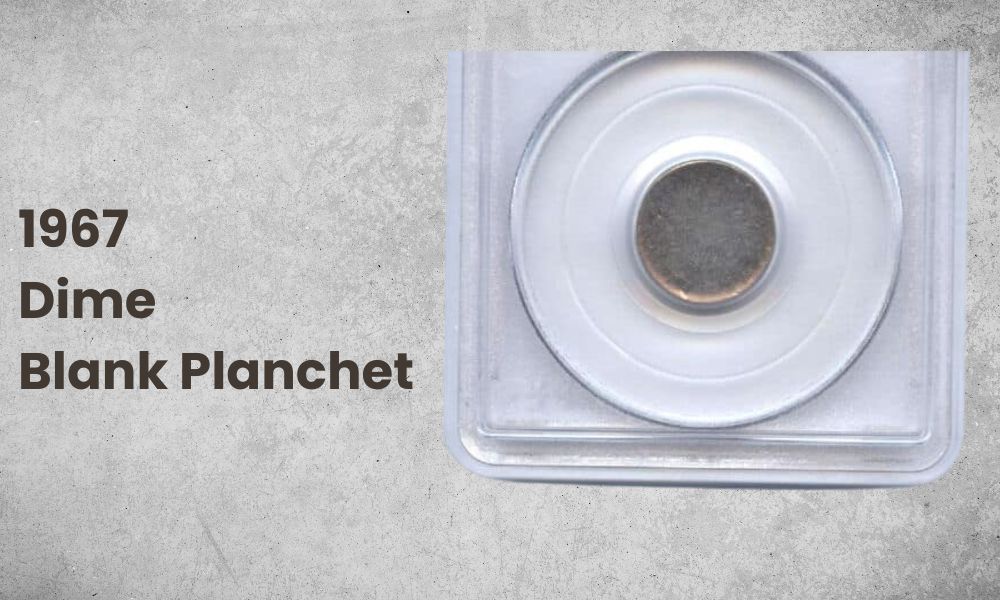
This is the type of error that you just can’t miss – having a coin with a blank planchet means that it literally wasn’t stricken on one or both of its sides. Such a coin will be 100% blank on the side in question. If it’s blank on both sides, you can only identify it through its size and composition. Unfortunately, coins with this error won’t cost more than $1 to $2 tops because they are just not visually appealing.
1967 Dime Off-Center Strike
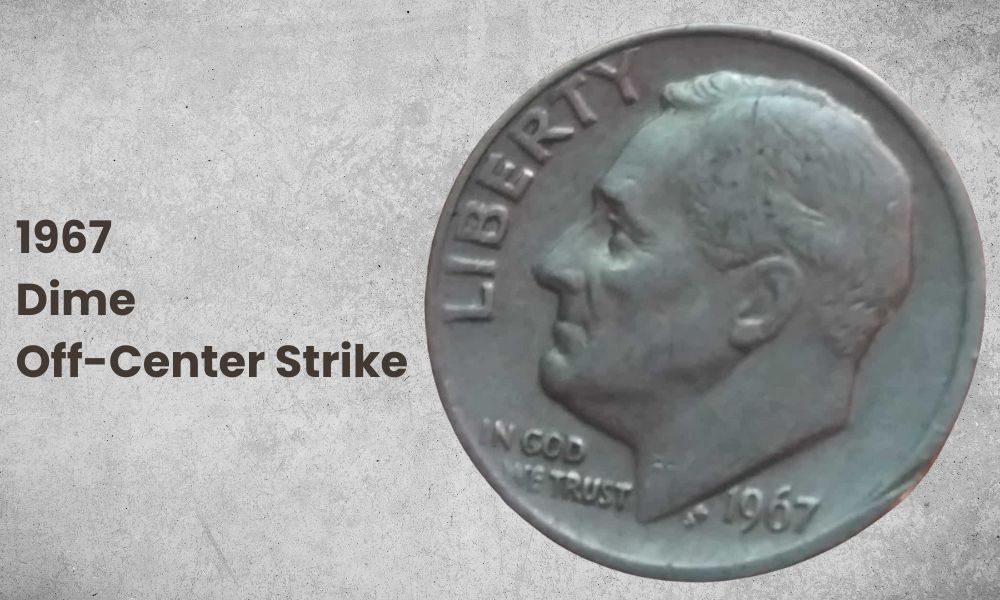
This error can occur in any type of coin and it’s not impossible for dimes too. As the name implies, this error happens when either the lettering or the image on either side of the coin gets displaced by even just a little bit. Depending on how off-center the strike was, this error can even lead to some pretty sizable blank patches on the coin. When this happens, such a dime can cost as much as $15 or $30.
1967 Dime Missing Clad Layer
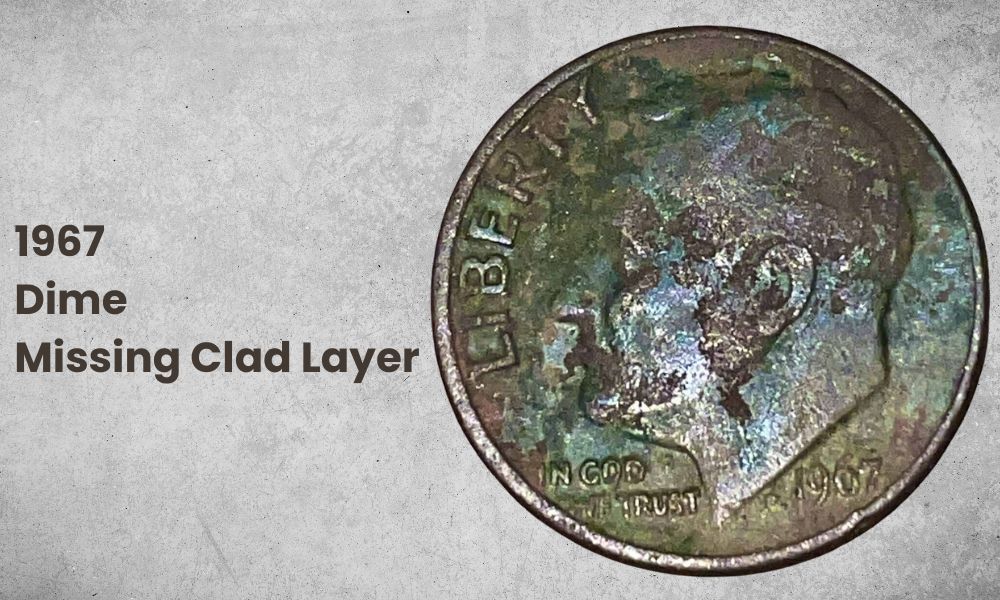
These so-called “naked dimes” happen when their nickel-copper top layer hasn’t been applied to the dime’s planchet. When this happens, the coin’s copper core gets exposed to the elements and deteriorates much more easily. A coin with this error that happens to still be in good condition can cost as much as $20.
1967 Dime Clipped Planchet
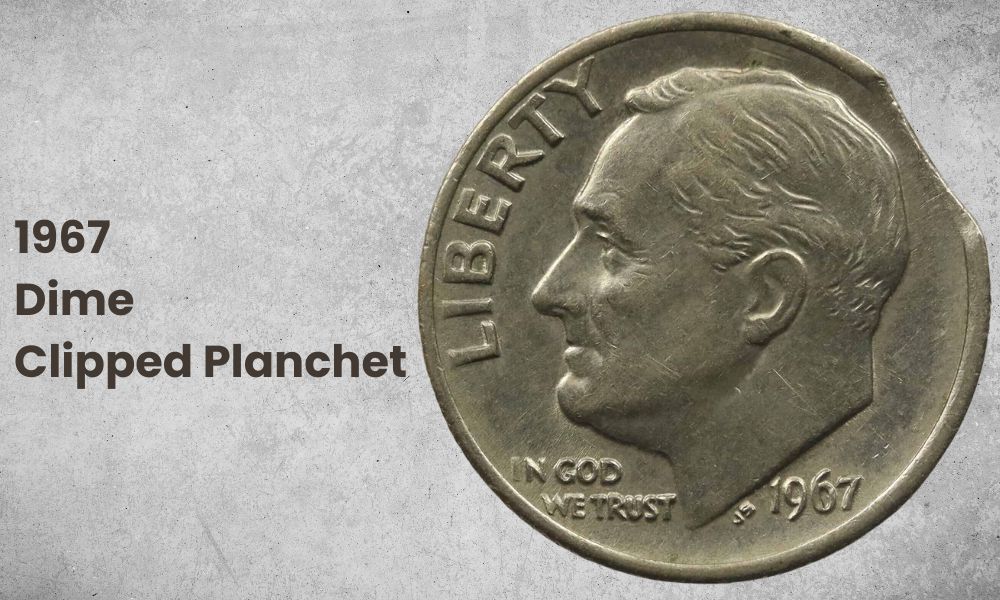
This fascinating error can be seen on a few Roosevelt dimes and can appear more numerous for these coins than for others, although that’s probably just because of how many dimes there are overall. In essence, a clipped planchet is what happens when the planchet isn’t fed properly into the striking hub.
The end result is typically a missing side of the coin, usually looking as if it’s been chipped off. This can bump a coin’s price up to $30 to $40.
1967 Dime Broadstrike
Broadstrike errors occur when the die collar has been positioned improperly. When this happens, the planchet’s rim gets stricken too broadly, and the lettering and imaging on not one but both sides of the coin will appear stretched and deformed. This error, while not too visually appealing, is still quite peculiar and can ramp up the coin’s price up to $5 or $10.
1967 Dime FAQ
Is there anything special about the 1967 dime?
For such a common coin, the 1967 dime has quite a few rare features. It’s the first Roosevelt dime to be minted in a quantity of over 2 million from a single Mint. Plus, it also doesn’t bear the Mint’s mark and instead has the initials of its engraver – “JS”. This dime was also the first to have a Special Mint Set rather than a proof coins set.
Is a 1967 with no mint mark valuable?
Overall – no, not particularly. Some 1967 dimes can fetch prices in the dozens or – extremely rarely – in the hundreds, but, overall, a 1967 will cost its face value or just a little over it.
How much is a 1967 dime worth?
Most 1967 dimes will be worth $0.10 to $0.15, i.e. – their face value or a tiny bit above it if there is something mildly interesting about them. Rare few can cost several dollars or even several dozen dollars if they are in great condition and have some interesting errors or features. The most special cases can cost up to $300 or $400 but most people are unlikely to ever see such a dime.
